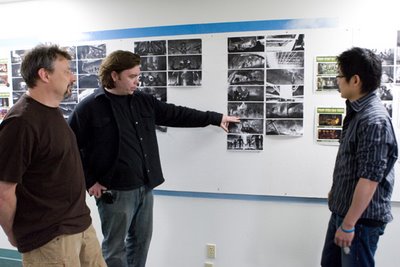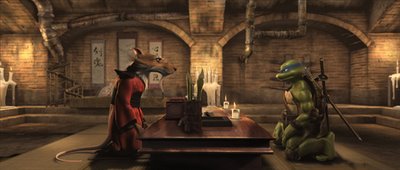CHICAGO – In anticipation of the scariest week of the year, HollywoodChicago.com launches its 2024 Movie Gifts series, which will suggest DVDs and collections for holiday giving.
‘TMNT’ Director Kevin Munroe Envisions R-Rated CGI
CHICAGO – “CGI is getting hampered by being defined as a ‘kiddie’ medium,” said “TMNT” writer/director Kevin Munroe in an interview with Adam Fendelman.

Photo courtesy of Imagi and Warner Bros.
Rather than solely because their kids lugged them to the movies, he envisions adults also flocking to engage the high-tech, highly immersive medium for themselves.
“In this small step with the [Teenage Mutant Ninja Turtles], you start to show that there’s a broader audience for it than just kids – when it’s done right,” Munroe said. “I’d love to be in the position where eventually we’d have an R-rated CGI horror or fantasy film.”
In the meantime, the experience for Munroe was an evolutionary process that he views as a glimpse into the next generation of film. He landed the Warner Bros. project from Turtles creator Peter Laird through aggressive tenacity.
“While working on a separate project with Imagi, I heard they were getting the rights to the Turtles,” Munroe said.
He continued: “I just kept on bugging them. I would send them e-mails in the middle of the night to keep pestering them. After I had a meeting with Peter, he signed my Turtles comic issue No. 1 from 1985: ‘Dear Kevin: Make a good movie or else…’”
Giving justice today to a brand that achieved cult status with its comic books required going overseas.

Photo courtesy of Imagi and Warner Bros.
In the process of removing the actors from the actual spotlight and merely using their voices, Munroe had to staff a gargantuan team of animation artists to artificially bring characters alive in a manner that’s reminiscent of real life.
The film’s makers decided to create and then bridge their own digital divide. While some computer artwork was done in California, the majority was done in an entirely different time zone, on an entirely different continent with people of an entirely different culture.
Munroe found his wealth of talent in Hong Kong. Until the artists learned to understand “Kevinspeak,” though, he recalls early confusion in response to his direction.
American words such as “cool,” for example, were misinterpreted there to mean the temperature rather than his stamp of approval. As such, the Hong Kong artists were given a crash course in Americanisms.
“For one of the warehouse scenes, I wanted to have wooden palettes in the background,” Munroe said, who speaks in a lot of slang. “Instead, they kept sending me pictures of people with their mouths open.”

Photo courtesy of Warner Bros.
Beyond the language barrier, traversing the long road that has added $71.3 million in the film’s worldwide piggy bank required massive technology demands.
The last time the sewer-dwelling bipeds captured audiences in 1990, its makers couldn’t have remotely conceived of today’s advances. The 2007 incarnation faced an entirely brave new world.
Munroe used a fat T-3 pipe, which flies data at speeds up to 44 Mbps, to communicate back and forth between his two hubs.
Rendering is done one frame at a time, and for “TMNT,” Munroe was sent 24 two-megabyte files for every second of film. A fight scene in a garden, which comprised just one of the film’s 91 minutes, took one year to complete.
Even an enormously high-tech film with a production budget of $34 million feels the sting of modern-day failure.

Photo courtesy of Imagi and Warner Bros.
“Just as we were getting into the crunch of the movie, there was an earthquake in Taiwan right after Christmas,” Munroe said. “We had hundreds of thousands if not millions of images coming over, and when the earthquake happened, our T-3 got cut out. We actually had people flying in from Hong Kong with hard drives on their laps. They were delivering the film by hand.”
The computer-modeled magic for the film, which came alive through researchers developing musculature and details such as skin translucency, doesn’t necessitate the enterprise-level equipment you might expect. Munroe added: “At the core of it, we just had a bunch of regular PCs.”
The project worked in a Linux environment using software such as Maya and RenderMan.
“We designed full-on muscle systems for the Turtles because they’re essentially wearing nothing but a sash and a half-shell,” Munroe said in the film’s production notes. “We also gave them unique characteristics. For example, on Raphael, he actually has veins that pop out whenever he flexes and Michelangelo has freckles.”
For help with all the minutiae, Munroe enlisted veteran art director and concept illustrator Simon Murton whose work ranges from “I, Robot” to “The Matrix Revolutions”.

Photo by Peter Winterstellar and courtesy of Warner Bros.
Voice work went to Patrick Stewart, Sarah Michelle Gellar, Kevin Smith, Laurence Fishburne, Ziyi Zhang and Chris Evans. Mako was announced as the voice of Splinter the day before he died. By then, he had finished the majority of his acting.
A “pseudopod” in 1989’s “The Abyss” marked CGI’s foray into the industry.
 | By ADAM FENDELMAN |


